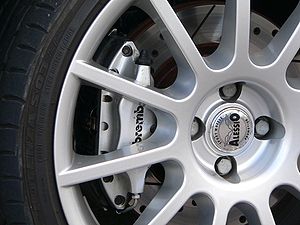 Image via Wikipedia
Image via WikipediaAlthough, electric system assistance is introduced in most of the vehicles now, the basic system for power steering developed mechanically, was also an ingenious creation. The working of this system can be understood in three stages, explained as follows.
Power Steering Pump Pulley
The pumps used in this process are attached or connected to the pump casings designed to support the structure. These pumps are nothing but pulley systems, which form a round structure with small grooves on their sides. A runner belt and pulley arrangement is interlocked and work in tandem by power supplied due to the spinning of the crankshaft. This crankshaft is the core of the engine power delivery system for pumps. These pumps consist of rotor mechanism that rotates rapidly, and thus pressurizes the fluid driving the power steering system. Electric pumping is used alternatively, avoiding the use of engine and making the system more fuel efficient.
The power steering fluid is propelled out of the pump by the fast rotating action of the rotor. The pressure regulator ensures that a pressurized fluid reaches the steering mechanism, where it acts as a lubricant and also reduces the heating effect of the system. The power steering mechanism and the gears located in the power steering gear box are operated on the power supplied by the pressurized liquid.
Power Steering Gear Box
The gear system used for power steering consists of either of two functions, rack and pinion or recirculating ball type, out of which the former is used most commonly. The pinion is connected firmly to the steering shaft, which is nothing but the mechanism attached to the steering wheel. The fluid enters either of the right or left side of the arrangement, as directed by the valves. The pinion is attached to the steering shaft by means of a torsion bar.
Power Steering Pump Pulley
The pumps used in this process are attached or connected to the pump casings designed to support the structure. These pumps are nothing but pulley systems, which form a round structure with small grooves on their sides. A runner belt and pulley arrangement is interlocked and work in tandem by power supplied due to the spinning of the crankshaft. This crankshaft is the core of the engine power delivery system for pumps. These pumps consist of rotor mechanism that rotates rapidly, and thus pressurizes the fluid driving the power steering system. Electric pumping is used alternatively, avoiding the use of engine and making the system more fuel efficient.
The power steering fluid is propelled out of the pump by the fast rotating action of the rotor. The pressure regulator ensures that a pressurized fluid reaches the steering mechanism, where it acts as a lubricant and also reduces the heating effect of the system. The power steering mechanism and the gears located in the power steering gear box are operated on the power supplied by the pressurized liquid.
Power Steering Gear Box
The gear system used for power steering consists of either of two functions, rack and pinion or recirculating ball type, out of which the former is used most commonly. The pinion is connected firmly to the steering shaft, which is nothing but the mechanism attached to the steering wheel. The fluid enters either of the right or left side of the arrangement, as directed by the valves. The pinion is attached to the steering shaft by means of a torsion bar.





